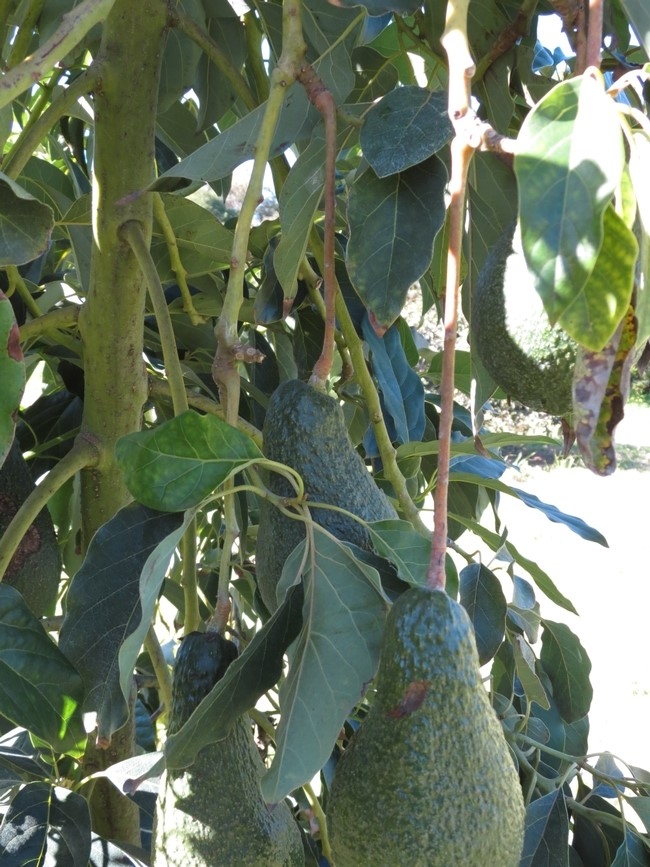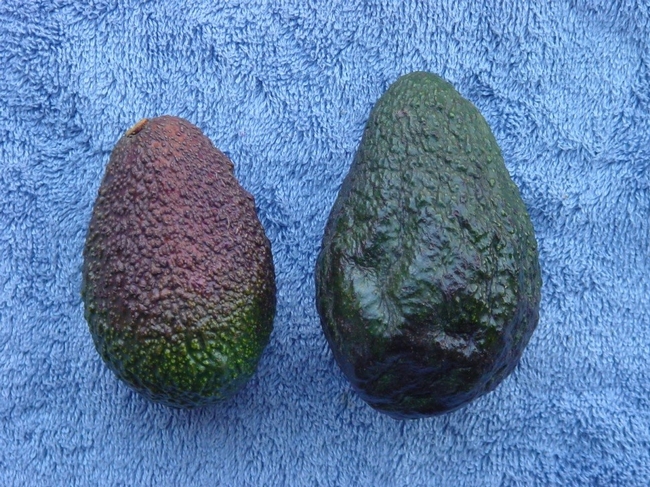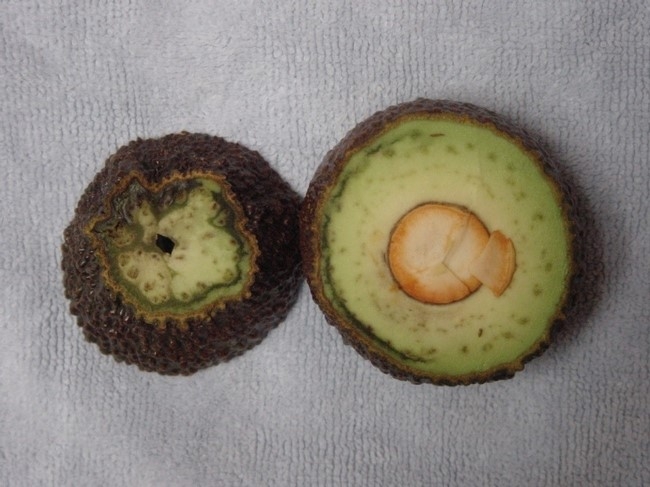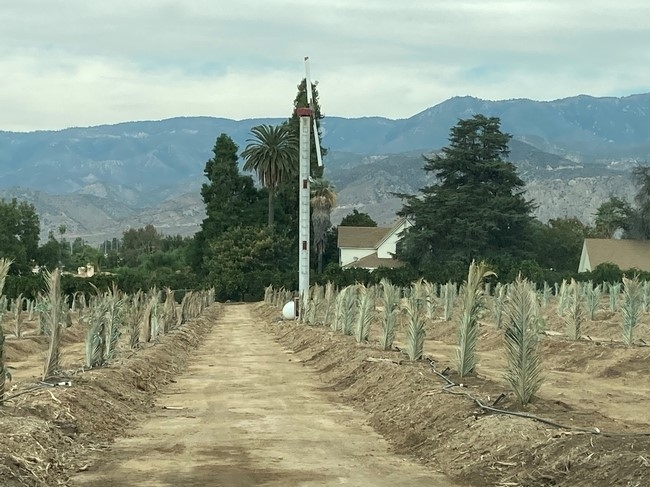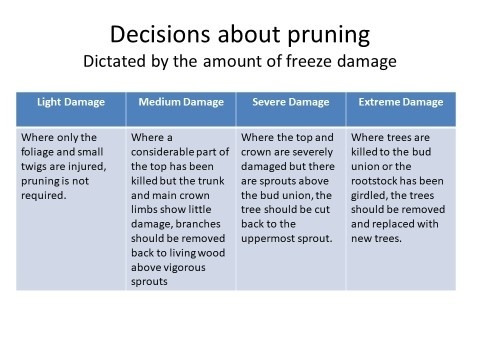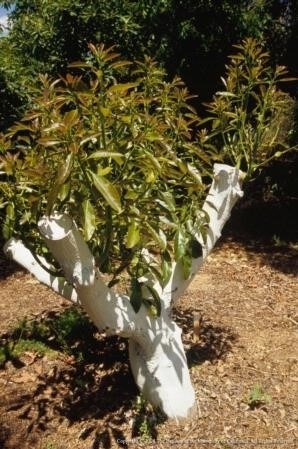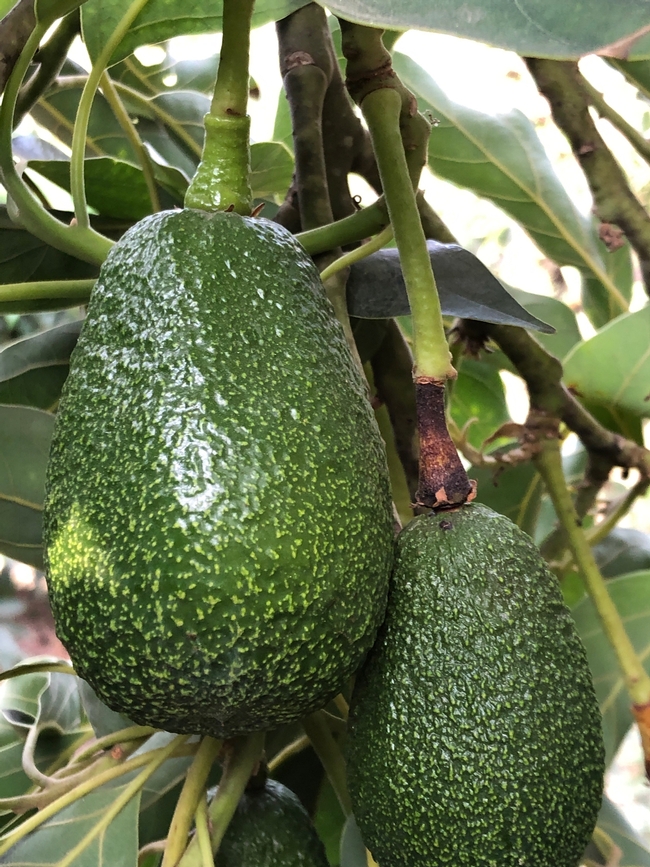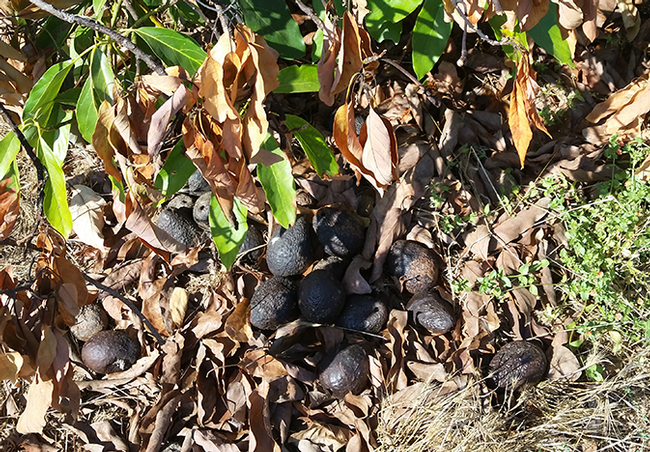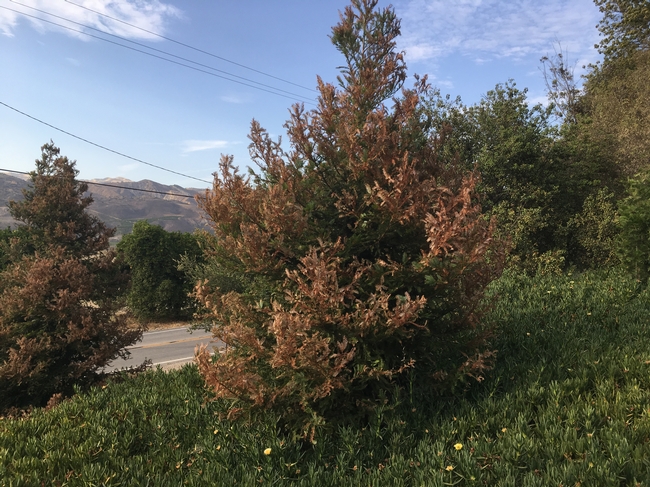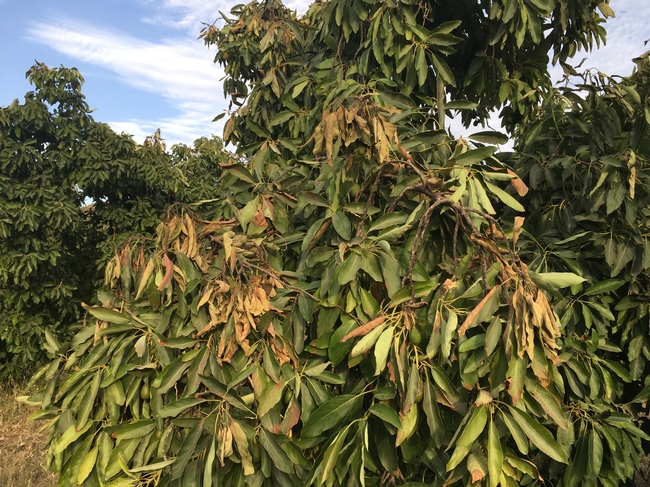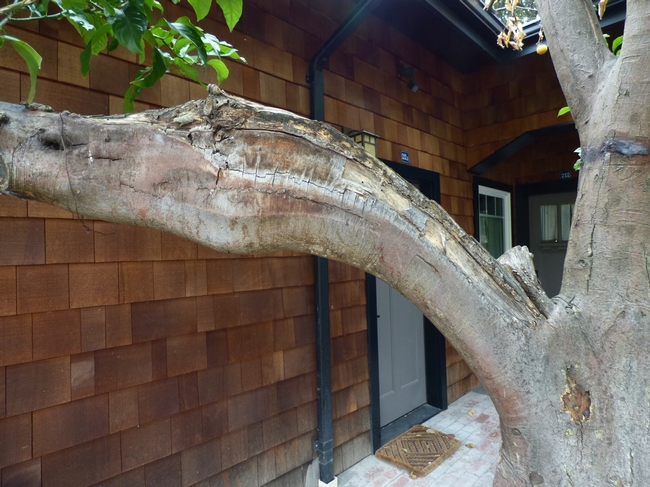
Posts Tagged: recovery
Frost in some part of Southern CA
Protecting Avocados from Frost and Then What
The long-range forecast is for no or little rain in Southern California. A dry winter often means a cold winter. A winter when frost and freeze can occur, And over the years, it seems like if there is a freeze in Chile in their winter, we can get one here, but 6 months later. Chile had a freeze this year.
The following is an outline of how a grower can prepare for cold events. Some require considerable advance preparation – plant the right variety – and some can be instituted right away – protection of young trees with palm fronds. The guidelines here are specific to avocado, but for the most part apply to lemon and other cold sensitive citrus.
Frost damage reduces tree growth and fruit yields. Thus, it presents a problem to the avocado grower who must develop and maintain high production to have a profitable business.
Before choosing frost protection equipment, however, the individual grower should ask the question: “Will the fruit and foliage saved pay for the trouble and expense of protection?” In some places, a small amount of damage may not fully justify the installation and operation of frost protection equipment. In other places, avocados can be grown only if expensive heating is done. Nearly all locations have sufficient cold to cause the grower to take into account probable frost damage, possible methods of protection, and the long-range economic effect of his frost situation.
How Frosts and Freeze Occur
Before considering the methods of frost protection, one should understand the conditions under which low temperatures occur. To differentiate between the two major sources of the cold, the terms local radiation frost and freeze are used.
Local radiation frost
Frosts are caused by a cooling of the objects on the earth's surface during the night. This loss of heat from the foliage and soil is called radiation. Heat accumulated from sunshine during the day is radiated to the sky during the night. The cooled objects chill the surrounding air and usually the coldest zone is near the ground surface. Air temperatures are warmer as one goes higher until a height is reached where they are at a maximum for that location. This is called the ceiling. The temperature and height of the ceiling is different for each place and situation.
When the ceiling is low, warm air is nearer the ground than when the ceiling is high. This phenomenon, occurring frequently in Southern California, is called temperature inversion and accounts for this area's ability to protect its orchards.
Colder air settles near the ground and then moves (flows) down the slope to still lower ground resulting in what is called the drift.
Terrain features and winds influence its direction and velocity. A strong drift maintains air temperatures higher than those existing when little or no drift is present.
Freeze
The other type of freezing weather occurs when a large mass of cold air moves in from the north. Fortunately, these freezes have not occurred frequently. The major ones were in 1913, 1922, 1937, 1949, and 1950. Under freeze conditions, temperatures usually go below those experienced during local radiation frosts. When this cold air moves in, high ground is no warmer than lower ground and there is little or no ceiling. Orchard protection at such time is difficult, and methods employing the addition of heat are most effective.
Measuring Temperatures
Orchard temperatures are usually measured with a specially designed self-registering minimum thermometer mounted in a standardized shelter. In this way, readings are comparable and experience allows the grower to use these air temperature readings in judging his hazard and operating his equipment. The height of the thermometer above ground should be five feet in mature orchards and two feet in nurseries and recently planted orchards.
Most orchards have areas which are colder than other areas. You should have enough thermometers to measure temperatures in each of these areas. In establishing thermometer locations in a new orchard, set up one thermometer in a permanent reference location. Move the other thermometers around every few nights until you find the cold spots. With this experience, you can locate and determine the number of thermometers needed. The range in numbers will be from a minimum of two or three for small groves to one for each three to five acres in larger orchards.
Types of Injury
Fruit damage
Fruit damage consists of frozen stems, frozen fibers inside the fruit, or frozen flesh and skin, depending on the temperatures and their duration. This damage appears slowly and is difficult to appraise accurately.
For some varieties, principally in the case of the ‘Hass', the first evidence of damage will show up as a browning on the stem a few days after a frost. If this is the only damage, mature fruit might be picked and marketed. This all depends on the packer. The problem often is assessing how extensive the damage is. Unless this fruit is harvested, it will fall from the tree. Frozen fruit of other varieties, particularly the Guatemalan types, may never show the browning but will drop anyway.
Stem Damage
Frozen fruit fibers (vascular bundles) turn black and California law prohibits the marketing of all seriously damaged fruits. Before you pick mature frosted fruit, you should call in your marketing organization representative and local agricultural inspector to help you determine how much of the fruit should be harvested. By cutting representative fruit, they can tell whether it is within the legal tolerance or not, and guide you in marketing your fruit.
Severely frozen fruit may show brown water-soaked spots in the skin, gray areas in the flesh, and may even crack or split. It is unmarketable and will drop from the tree in time.
Water soaked and frosted neck, Mary Lu Arpaia
Brown vascular bundles, Mary Lu Arpaia
Tree damage
Frozen blossoms, leaves, and twigs turn black within a few days. But larger wood, although frozen, may never turn black. Great variation occurs in the location of tree damage. In some cases, only the lower part of the tree will be frosted, while in other cases only the top part is affected. Sometimes, only a limb on one side will be frosted. Thus, it is impossible to evaluate accurately the extent of wood damage until new growth comes out the following spring and summer.
Trees suffering moderate wood damage usually will not bloom properly and will produce a reduced crop the following season. Occasionally, trees have been killed all the way to the ground by severe freezes.
Tree Resistance
The resistance of the fruit and trees to freezing temperatures helps determine whether a grove must be protected or not. Then, too, both the minimum temperature and the duration of damaging temperatures affect the amount of injury. For example, three or four hours of 29 degrees may injure an orchard more than a brief drop to 25 degrees.
Frost susceptibility varies greatly from situation to situation. Adequate appraisal of each situation should include consideration of the following variables.
Age and crowding
Young trees (up to 3 years of age) and recently top-worked trees of all varieties may be killed by temperatures which would only cause minor damage to nearby mature trees. Protection for such trees is a wise practice, even in warm locations.
In general, older trees of a given variety are more resistant, except in orchards where they are crowded. Where the soil is shaded during the day, it cannot absorb the sun's heat and thus has little heat to give off during the night. Crowding also restricts the drift through the grove and increases the difficulties of orchard heating. For these reasons, thinning groves is often advisable to reduce their frost hazard.
Health
Weak trees are more subject to frost damage than healthy ones. Be sure your trees go through the whole year with an adequate supply of moisture; withholding irrigation water in the fall to “harden them up” can actually weaken trees and make them more susceptible.
Growth flush
Occasionally avocado trees are in a growth flush (a period of rapid new growth) when freezing temperatures occur. This is not usual, but unseasonably warm weather may stimulate a tree into abnormal growth in the winter. To avoid stimulation, pruning should be delayed until early spring. When tender growth occurs in the winter, growers may have to provide additional protection or sustain damage.
Size of crop
Trees with large crops are more susceptible to frost. To save this fruit, temperatures would have to be maintained one or two degrees higher than would otherwise be necessary.
Varieties of avocado
A wide range of susceptibility occurs among avocado varieties. To classify them according to their resistance is difficult because of the variations already mentioned. But the races of avocados do exhibit differences and can be used as frost resistance indicators.
The Mexican race is the most resistant, and is able to withstand temperatures about as well as orange trees.
The Guatemalan race is the most susceptible grown in California. Some varieties are slightly more resistant than others, so the race can be divided into tender and very tender classifications. Because the fruit is immature during the winter, the crop may be lost while the trees will suffer only minor damage. Lower temperatures will seriously damage trees and affect their future productivity.
The hybrids, as typified by the Fuerte, are intermediate in their frost resistance, and are in about the same class as lemon trees. Because of the Fuerte's importance, it has become the standard measure of frost resistance. Protection is usually provided to save the Fuerte crop since the fruit is mature in the winter months.
As a guide to inexperienced growers, Table I gives a basis for establishing frost protection practices. The critical temperatures listed are for mature healthy trees. Other tree conditions might move these figures one or two degrees higher. Also, the duration of the damaging temperatures would affect the degree of injury. It is still not clear how much cold ‘GEM' variety can handle.
|
Table I – Variety Frost Resistance |
||
|
Race |
Typical Varieties |
Critical Temperature Below Which Fruit and/or Trees are Subject to Damage |
|
Mexican |
Duke, Topa Topa, Mexicola, Zutano, Bacon |
25 Degrees F |
|
Hybrids |
Fuerte, Puebla |
28 Degrees F |
|
Guatemalan (Tender) |
Ryan, Hass, MacArthur, Nabal, Edranol, Rincon, Lamb Hass, Sir Prize |
29 Degrees F |
|
Guatemalan (Very Tender) |
Anaheim, Dickinson, Carlsbad, Challenge, Hellen |
30 Degrees F |
Need for Protection
Frost protection is an expensive and disagreeable job which requires careful consideration by all growers. Each grower must determine his own needs. No one can predict accurately the frost hazard for a given location. Information can be obtained by installing the proper thermometers on the property. Observing adjoining orchards and talking with neighbors will give good background information.
The topography of the orchard and the surrounding land enters into the evaluation. Land on hillsides with steeper slopes is usually warmer than lower valley land. Locations with strong prevailing drifts, or exposed to winds, usually are warmer than sheltered areas having little air movement. Tall dense windbreaks can make a grove one or two degrees colder, but the lower branches of the windbreak can be trimmed to overcome this. Coastal areas usually have less frost hazard because the relative humidity is higher, and ceilings are lower than in interior areas.
As mentioned in the beginning, your final evaluation should answer this question: “Will the fruit and foliage I save pay for the trouble and expense of protection?” Often it is possible to take some damage every few years and still have a more profitable orchard than if equipment were purchased and operated. On the other hand, an investment in equipment, if properly operated, will save your trees and crops. The decision should be based on a long-range economic estimate, balancing the money lost by damage against the costs of protection. This same evaluation will determine the type of protection to provide, if needed.
In some counties and communities, smoke ordinances regulate the type of equipment and methods of operation to reduce smoke output. When you purchase new orchard heater equipment, it should be the most smokeless available in order to comply with possible future expansion or tightening of these ordinances. The trend toward eliminating smoky orchard heaters in most areas will affect the grower's choice of equipment.
Methods of Protection
Mature orchards
Only two general methods of protecting avocado groves have proved satisfactory – heaters and wind machines. A combination of these two also is used. Many makes and designs of heaters and wind machines are offered for sale and they must be compared on the basis of protection provided and cost of installation and operation. This publication is limited to their general application in avocado groves. Their actual operation is discussed in other available publications of the University of California.
Orchard heaters
Experience has shown that a large number of small fires burning throughout the orchard provide better protection than a few large fires concentrated in spots. The value of heaters is noted below to provide a basis for selecting the general type of protection needed.
Their advantages are:
- They usually furnish more adequate protection than wind machines. However, in extremely cold conditions they, too, can be inadequate.
- Only enough heaters to maintain safe temperatures need to be lighted.
- Additional heaters and oil can be stored in the field for emergency conditions.
- They distribute heat to all parts of grove.
Their disadvantages are:
- Smokiness. However, certain types have low smoke output when properly operated.
- Relatively high costs of investment and operation (Table II).
- Fire hazard due to mat of leaves beneath the trees.
- Trouble and work of operation and maintenance.
- High labor requirements.
For colder locations and positive protection, orchard heating is the only proven method. Pie line heaters, using either heater oil or natural gas under pressure from permanently installed pipelines, are efficient but very expensive. Economical and effective heating is provided by heaters with 9-gallon capacity bowls and improved designs of stacks burning a low grade of diesel oil. Usually 45 to 90 heaters are used per acre depending on the frost hazard.
Wind machines
In certain locations, wind machines have provided economical protection. Their effect is essentially that of a large fan which mixes the air within and above the orchard so that the average air temperature near the ground is raised.
Their advantages are:
- More economical than orchard heaters (Table III)
- Low labor requirements for operation
- Adequate protection against local radiation frosts when temperatures go only 2 or 3 degrees below the damaging point.
- Useful in increasing air movement in groves where dead air occurs.
- Increase effectiveness of heaters.
Their disadvantages are:
- Inadequate protection with freeze conditions or when temperatures go 4 or 5 degrees or more below the damaging point.
- Inadequate protection in locations where little or no ceiling occurs.
- Unequal protection throughout grove
- Less effective in young plantings.
Machines providing at least 5 horsepower per acre should be selected on the basis of cost and ease of operation. The location of the machine or machines in an orchard depends on the drift, the topography, and the other variables.
Combination heaters and wind machines
Usually 8 to 25 heaters per acre uniformly scattered throughout the grove are sufficient when used with an effectively installed wind machine. The combination provides adequate protection for even the colder locations. The wind machine will protect the grove for some of the nights by itself, but for the very cold nights, the heaters are available to add heat and thus provide positive protection. Usually the heaters are lighted whenever the wind machines cannot maintain the temperatures above the danger point.
This combination method has the advantage over heaters used alone in that it is cheaper, while providing as complete protection.
A great many other types and methods of protection have been tried but because of one or more faults in each, they cannot be recommended.
Protecting Young Trees
Orchard heaters and wind machines are less effective in protecting young trees in their first two or three years in the orchard than other methods which are usually cheaper, anyway. The first consideration in protecting newly planted trees is to have the trees as large as possible. Planting and topworking should be done in the spring so the trees will make the maximum growth during the summer and fall, before low temperatures occur in the winter.
In locations having serious frost hazard, you might try the practice of planting Mexican seedlings in place in the field and permitting them to grow for 2 to 3 years before topworking. Then if the topworking is done early in the spring, the young trees will have made enough growth to better withstand the cold of the following winter.
Protection for young trees is best accomplished by sheltering them from radiation heat loss. Shelters for this purpose are of many types. In cold locations, young trees may require several types of protection; they may be wrapped with paper, mounded with dirt, or surrounded with corn stalks.
Use of palm fronds for both sun and frost protection, Leo McGuire.
Care of Frost Damaged Trees
Determining the amount of damage is often a difficult job and cannot be done accurately for some months following the freeze. It is usually better to let the tree recover by itself.
Sunburn prevention
Exposed limbs can be badly damaged by sunburning. Whenever defoliated tree s have not grown enough new leaves to protect the limbs before hot weather occurs, you should provide protection.
Protection is best provided by spraying or painting all exposed limbs with either a cold-water white latex paint or a whitewash. The paint needs to be white enough to reflect the light, but thin enough to flow through a sprayer. With latex paint, a 2-part latex to 1 part water is usually adequate.
Irrigation
Do not irrigate frosted trees until the soil in the root zone approaches dryness. The loss of leaves reduces the use of water so the soil will remain wet longer than with unaffected trees. Careful, frequent examination of the soil is necessary to prevent excess moisture from normal irrigations. Avocado root rot occurs in soils with excessive moisture when the cinnamon fungus is present, and growers must guard against this disease following frost damage.
Pruning
Do no pruning until you know how much of the tree has been killed. New foliage will grow from the remaining live wood and the tree will recover better without pruning.
When new shoots are at least two or three feet long, you can remove the dead wood. This will usually be mid-summer, 6 to 8 months following the frost. At the same time, suckers should be thinned out to select the new limbs to replace those lost.
Care of young trees
Badly frozen young trees usually develop strong sucker growth which can be used to form a tree as good as a replanted tree. If these suckers are from above the bud union, you can develop a new top by thinning and training. On young trees frozen back to below the bud union, strong root suckers can be budded or grafted to the desired variety the following spring. If the sucker growth is weak, the tree should be removed.
Severely frozen mature trees
The handling of severely frozen mature trees where they have been killed back to the large scaffold limbs, to the trunk, or to the ground, presents many problems. Each tree should be considered separately. Often growers should topwork badly frozen trees to a more resistant or productive variety.
Whitewashed and topworked frozen tree
And a lot more information from the CA Avocado Commission
Frost and Frost Protection Source of Information
You wanted to know all about Frost, well it's all here. Emeritus Rick Snyder put it together over the years and it's at your finger tips.
English Frost Protection Training Units (videos)
Spanish Frost Protection Training Units (videos)
When to Turn Sprinklers On and Off for Frost Protection
FP001 Quick Answer—This quick answer provides information on using a psychrometer or temperature and dew point data to determine when to start and start sprinklers for frost protection.
Predicting Temperature Trends during Freeze Nights
FP002 Quick Answer—This quick answer gives a method for predicting the change in
temperature during a calm, radiation freeze night.
A Simple Method to Measure the Dew Point Temperature
FP003 Quick Answer—This quick answer provides information on how to measure the dew point for use in estimating minimum temperature and for starting and stopping
sprinklers for frost protection.
Sprinkler Application Rates for Freeze Protection
FP004 Quick Answer—This quick answer provides information on the sprinkler
application (precipitation) rates needed to protect crops from freezing.
Principles of Frost Protection
Frost Protection Training Units (videos) on measuring temperature, frost protection with water, frost protection with wind machines, and passive protection. Traning units are availble in English and Spanish .
FP005 Quick Answer—This quick answer provides information on the general principles of well-known frost protection methods. A PDF file of the WEB page can be uploaded from this Quick Answer. In addition, a shorter version is available.
Programs for Estimating Frost Night Minimum Temperatures and Temperature Trends (new 7 Mar 2007)
The FFST Excel application programs FFST_E.xls and FFST_M.xls are available from this link. The FFST application helps users to determine an empirical equation for estimating minimum temperatures during radiation frost nights. Note that the program will provide good estimates if there is little or no wind, no significant cold air drainage, and no clouds.
The FTrend Excel application programs FTrend_E.xls and FTrend_M.xls are available from this link. The FTrend application program is used for estimating changes in air and wet-bulb temperatures during a frost night. The application is useful for predicting when to start sprinklers for frost protection and for other methods as well.
Estimating Risk of Frost Damage from Climate Data (new 8 Jul 2006)
One of the programs included with the book Frost protection: fundamentals, practice, and economics. Volume 2, which is available from the UN FAO is the Frisk program. Information on how to obtain the book is presented above on this web page. Based on reader feedback, some improvements have been made to the Frisk application since the book was published. Updated versions of the application are made available to the public here. The Frisk program is an MS Excel application that is designed to help growers to make decisions on the risk of frost damage in a particular location. The user inputs the local climate data and a critical damage temperature, and the application computes the probability of temperature falling below the critical temperature on each day of the year. These data are then used to estimate the length of the growing season relative to the critical temperature by presenting a graph of the probability that the growing season will be less than a specific number of days. The application also computes the certainty that no air temperature will fall below the critical damage temperature after a selected date in the spring or before a selected date in the fall for design periods of 5, 10, …, 30 years. This certainty of no events is equivalent to the risk of having one or more events during the same time period. Although Celsius temperature was used in the example application programs, the program works equally well using Fahrenheit temperature. To obtain a copy of the application, click on FriskNH.xls for the northern hemisphere or FriskSH.xls for the southern hemisphere. Note that metric units were used in the Frisk application sample data.
Public Value: UCANR: Promoting economic prosperity in California
Avocados Get Hot
If you see significant leaf drop in your groves due to excessive heat, the following actions are recommended:
- As soon as possible, whitewash branches exposed to the sun with special attention paid to branches on the west and south sides of the tree.
- Trees that lose a significant portion of leaves cannot efficiently move water, therefore restrict irrigation amounts to ensure you avoid creating wet, soggy conditions that can lead to root rot. It's best to irrigate less frequently and with smaller amounts of water.
- Do not prune your trees — leave hanging leaves in place to protect the tree from sunburn. Once new tree growth has occurred (in the next 3 – 6 months), pruning can take place on living wood.
- Adjust fertilization as you would with a frost-damaged tree: reducing the amount of fertilizer until the tree is re-established. If you see signs of a particular nutrient deficiency, adjust fertilization accordingly.
For more information about managing heat in avocado groves, growers can view the following articles on the California avocado growers' website:

heat damage gem avop
Fire Resources
Current fire activity in Ventura County reminds us that fire season is here. It's critical to be prepared. Here are some important resources to help you get ready and stay apprised of fire activity in Ventura County.
For the latest fire incident information, visit the Ventura County Fire Department website. This website also contains a wildfire action plan for farmers, ranchers and growers.
We also suggest you bookmark the VC Emergency portal. You can access the Ventura County Emergency Preparedness Guide in English and Spanish.
Here are other resources we recommend:
- Fire in California This is UC ANR's comprehensive fire resources website. This site contains the latest information on fire ecology; wildfire preparation; health and safety in wildfires; wildfire recovery; and more. Useful information for homeowners, land owners and land stewards.
- CA Fire Science Consortium is a network of scientists and managers that strives to increase the awareness, understanding, and adoption of wildland fire science information.
- LUC Lab at UC-Berkeley researching land and land use change.
- ReadyForWildfire.org CalFire's fire resources website, which provides many valuable resources for preparedness.
- **NEW Wildfire Risk to Communities maps by US Forestry Service
Be sure to follow our UCCE Livestock & Range page on Facebook. Advisor Matthew Shapero helms that page and often posts fire information there. If you haven't had an opportunity to meet Matthew, you can learn more about his work in this blog post.
ICYMI, here's a #goodread about Pandemic and Wildfire: California is Preparing for a Crisis Within a Crisis
Stay safe.

Credit: Michael Held, Unsplash
Avocado Orchards After the Fire
The very fact that avocados can be grown in hard to get to places means that the trees are also in areas that are subject to wildfire damage. Recently several hundred acres of avocado burned in the foothills. The fire was fanned by high winds and low humidity.
Every year there are avocado trees that burn, either through careless attention to early morning fires that pickers build, wildfires or car accidents. A grower needs to be patient and observant to bring the trees back into production.
Although injury to foliage and young growth is visible within a few days of the fire, the full extent of the damage may not be known for several months or possibly the next growing season. In the case of severe injury, die-back may continue to occur for several months after the fire. New growth that occurs after the fire may suddenly collapse the following year when the growth is tested by Santa Ana conditions.
The important rule to follow after a fire is to do nothing - don't prune, don't fertilize and maybe don't water. Or rather, water very carefully. Dry winds may have sucked the water out of the ground and may need to be replenished. The fire may have burned the irrigation lines and need to be replaced.
The need to immediately replace irrigation systems will depend on the time of year, the extent of damage, the soil moisture after the fire, the weather forecast, labor availability and many other considerations. It is not terribly expensive to replace hoses, but if PVC sub mains have burned, it will be a big job and it may not be necessary to jump on their replacement. Check the soil and the tree status before rushing to replace an irrigation system. It is on the list of things to do, but maybe not tomorrow.
In the meantime, if the tree has been defoliated by the fire, it has lost its ability to transpire water. Watering a tree with no leaves will set up those conditions that are conducive to root rot. Until the tree begins to leaf out, watch soil moisture to decide how much water the trees are pulling out of the soil. The emitters should be capped or plugged on some leafless trees. Then as the tree puts on new growth, shallow, infrequent irrigations should start. This may mean replacing the 10 gph microsprinkler with a 1 gph dripper if only a portion of the orchard has been burned and the rest of the trees need their usual amounts and frequency of water.
The avocado has a tremendous ability to come back from fire and frost damage. However, the tree will tell you where it is coming back. It will start pushing growth where the tree is still healthy. It may take 3 to 6 months for this growth to occur.
Delay pruning until the tree clearly shows where it is going to regrow. By waiting, you save the expense of having to return sometime later to remove more wood and also will be able to save the maximum about of tree.
An activity the grower can perform is whitewashing. The defoliated tree can be further damaged by sunburn after it has lost its protective cover of leaves. The upper surface of horizontal limbs and the south sides of exposed trunks are the most affected. The whitewash can delay the appearance of new growth, but it does not affect total growth. There is usually no value in applying the whitewash to small limbs.
There are various commercial whitewashes on the market. The easiest to prepare is the cheapest white latex paint on the market mixed with water to the extent that it will go through a sprayer.
Avocado trees have a great ability to recover after fire damage. Even trees killed below the bud union will frequently develop into good trees if they are rebudded and given good care. Trees which do not put out vigorous sprouts should be removed. Interplanting avocados would rarely be advisable because of their rapid recovery.
Fire Information:
http://ceventura.ucanr.edu/Agricultural_Threats/Fire_Information/
For another version of fire recovery, go to: https://www.californiaavocadogrowers.com/cultural-management-library/post-fire-grove-recovery
Photos from Kevin Ball, firefighter/farmer

slow burn through orchard

watching the fire clear weeds

other side of the moon

water on the ashes
Frost Damage in July?
So, this weekend we had some hot weather and the damage from that heat is apparent in all kinds of plants. Sycamores, cottonwoods and willow in the Santa Clara River bottom look torched. Redwoods in the landscape look like a new disease has hit them.
Even old coast live oak in Ojai have been toasted. Orchards have been hit also with been hit without exception. This has been a widespread weather phenomenon like a major freeze. And the trees should be treated as if they have been freeze damaged.
//ucanr.edu/blogs/blogcore/postdetail.cfm?postnum=12275
So, what to do with the avocados and citrus that have been hit? Well, if it's just a slight toasting, nothing. They will grow out of it. It's a setback. The growing points, the terminal buds, have been damaged and in the case of avocados those may not flower next spring. If the damage is not extensive, the whole canopy has not been damaged, then flowering should be sufficient for a good crop next year. If the whole canopy has been hit, it's likely that flowering will be minimal next year.
If the trees have lost significant portions of the canopy, though, the heat damage is not the problem, it's the sunburn damage that is going to happen that is the problem. It's the loss of the leaves that transpire and cool the tree that lead to this kind of damage that can kill small trees and lead to significant branch loss in older trees.
The leaves act like the radiator in a car. They move water through the tree and that water movement carries off the heat that accumulates in the branches and stems. When water flow stops, the bark heats up and tissue is damaged. The worst-case scenario occurs when a “renovated” tree that has been brought down to 6 feet in January and since then there has been new growth all over the tree. The heat fries that new growth and now the whole tree structure is exposed to sunburn damage.
The branches exposed to the sun need to be protected with whitewash. The whitewash needs to be WHITE, not grey. It needs to be able to reflect the sun and prevent the surface from heating. The tops of branches and the west and south sides need to be the most protected, so it often involved hand work. And it needs to be done soon after the canopy loss. That wood heats up fast and damage occurs soon after it heats up.
So what else needs to be done? No canopy, no water loss, so it's necessary to manage the water differently. With no leaves, there is no water moving from soil through the tree, so it just sits there, and the ground stays wet. Perfect conditions for root rot.
Growers who were watering their trees knowing that a heat spell was coming, did the right thing. It probably reduced the severity of the damage, but even growers who had water on before the heat and it was running during the heat have had damage. With canopy damage and loss, applied water needs to be restricted to just enough to get tree recovery without creating a wet, soggy condition. And with tree recovery, it's going to need a continually changing irrigation schedule as new growth occurs.
So now more than ever, water to the tree's growing needs. And the normal fertilizer program needs to be adjusted. There's probably sufficient nutrients in the soil from prior fertilization that nothing new needs to be applied.
And don't' prune the trees. Leave the hanging leaves there. They will help protect the tree from sunburn, but the extent of the damage is not clear. Let the tree push new growth and that will tell you sometime in the future 3-6 months, even a year from this event, when to do significant pruning.
Phlood, Phyre, Phrost, Fytophthora and Phahrenheit continue to plague our industry. It seems like we are always coping with some natural and some unnatural issues affecting agriculture. Oh, yeah and pH.
Photo: Heat singed new avocado growth.
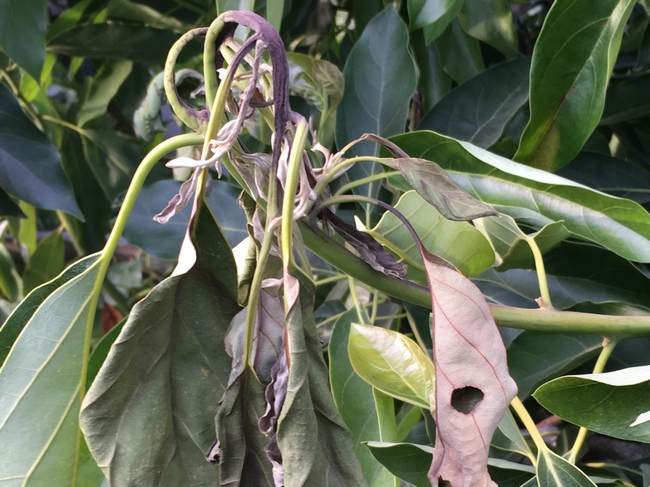
heat damage to new avocado

